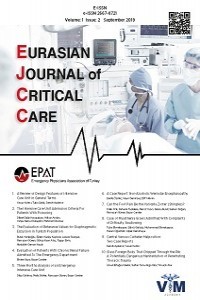Covid-19 Pandemic, Restrictions and Rhabdomyolysis
Covid-19 Pandemic, Restrictions and Rhabdomyolysis
COVİD-19, Pandemic, Rhabdomyolysis,
___
- 1. Lee G. Exercise-induced rhabdomyolysis. R I Med J 2014; 97(11): 22-4.
- 2. Zutt R, Van Der Kooi AJ, Linthorst GE, Wanders RJA, De Visser M. Rhabdomyolysis: review of the literature. Neuromuscul Disord. 2014; 24: 651-9
- 3. Talevi D, Socci V, Carai M, Carnaghi G, Faleri S, Trebbi E, et al. Mental health outcomes of the COVID-19 pandemic. Riv Psichiatr. 2020; 55(3): 137–4
- 4. Jacobsen GD, Jacobsen KH. Statewide COVID-19 Stay-at- Home Orders and Population Mobility in the United States. World Med Health Policy. 2020;29;10.1002/wmh3.350.
- 5. Furman J. When exercise causes exertional rhabdomyolysis. JAAPA. 2015; 28(4): 38-3
- 6. Rawson ES, Clarkson PM, Tarnopolsky MA. Perspectives on Exertional Rhabdomyolysis. Sports Med. 2017; 47(1): 33-9
- 7. Fernandes PM, Davenport RJ. How to do it: investigate exertional rhabdomyolysis (or not). Pract Neurol. 2019;19(1):43-8
- Başlangıç: 2019
- Yayıncı: Acil Tıp Uzmanları Derneği
Management of a Case of Gangrenous Cholecystitis Detected in the Emergency Department
Effect of Using Metoclopramide and Ondansetron in the Emergency Department on the Treatment Duration
Oya GÜVEN, Özlem TATAROĞLU, Dilay SATILMIŞ, Mehmet ERDOĞAN
Özlem BİLİR, Gökhan ERSUNAN, Asım KALKAN
Paraoxonase Activity In Patients With Chronic Obstructive Pulmonary Disease
Kerim YEŞİLDAĞ, Turgut TEKE, Sami ERDEM
Posterior Reversible Encephalopathy Case In Emergency Department
Dilber ÜÇÖZ KOCAŞABAN, Sertaç GÜLER
Pre Hospital Cutting-Punching Tool Injuries At Emergency Health Services: Konya Sample
Hasan KÜÇÜKKENDİRCİ, Serap BATI
Chronic Kidney Disease and Health Literacy
Hatice Şeyma AKÇA, Serdar ÖZDEMİR
Serhat ÖRÜN, Efe Mehmet Can KIRCA
Covid-19 Pandemic, Restrictions and Rhabdomyolysis
Bedia GULEN, Bahadir TASLİDERE, Yasin UGUR, Ayse Busra OZCAN, Ertan SONMEZ
